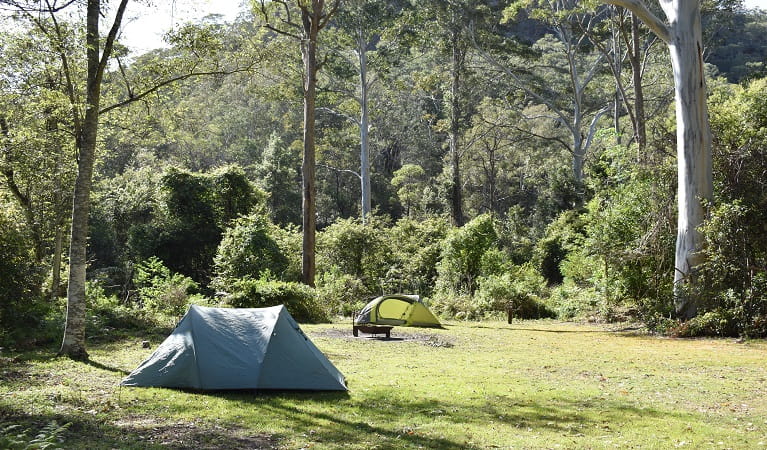Mill Creek campground
Dharug National Park
Overview
Mill Creek campground offers sites for small caravans, campervans, camper trailers and tents. Nestled among trees and surrounded by dramatic sandstone cliffs, this sheltered area makes a great weekend escape.
| Number of campsites | 31 |
|---|---|
| Camping type | Tent, Camper trailer site, Camping beside my vehicle |
| Where | 174 Mill Creek Road, Gunderman, NSW, 2775 - in Dharug National Park |
| Facilities | Barbecue facilities, carpark, toilets |
| What to bring | Drinking water, cooking water, insect repellent, firewood |
| Bookings | Bookings for up to 2 sites and 12 people can be made online. |
| Group bookings | There is an exclusive group campsite for up to 70 people, 500m from the general campground. Call Bulga office to book it. |
| Please note |
|
Pick a flat, grassy site by the creek and set yourself up amid the rugged sandstone escarpments and dense eucalypt forests. This pretty, sheltered area is loved by birds and wildlife too – you might see wombats, wallaroos, goannas, lyrebirds and tiny sugar gliders and hear the distinctive chiming sound of bellbirds.
Take a short walk to the picnic area where you'll find the start of a number of great bushwalks – experience rainforest and dry eucalypt forest, climb up onto the escarpment or ride along the Old Great North Road, part of the Convict Sites of Australia World Heritage Area.
Take a virtual tour of Mill Creek campground captured with Google Street View Trekker.
Map
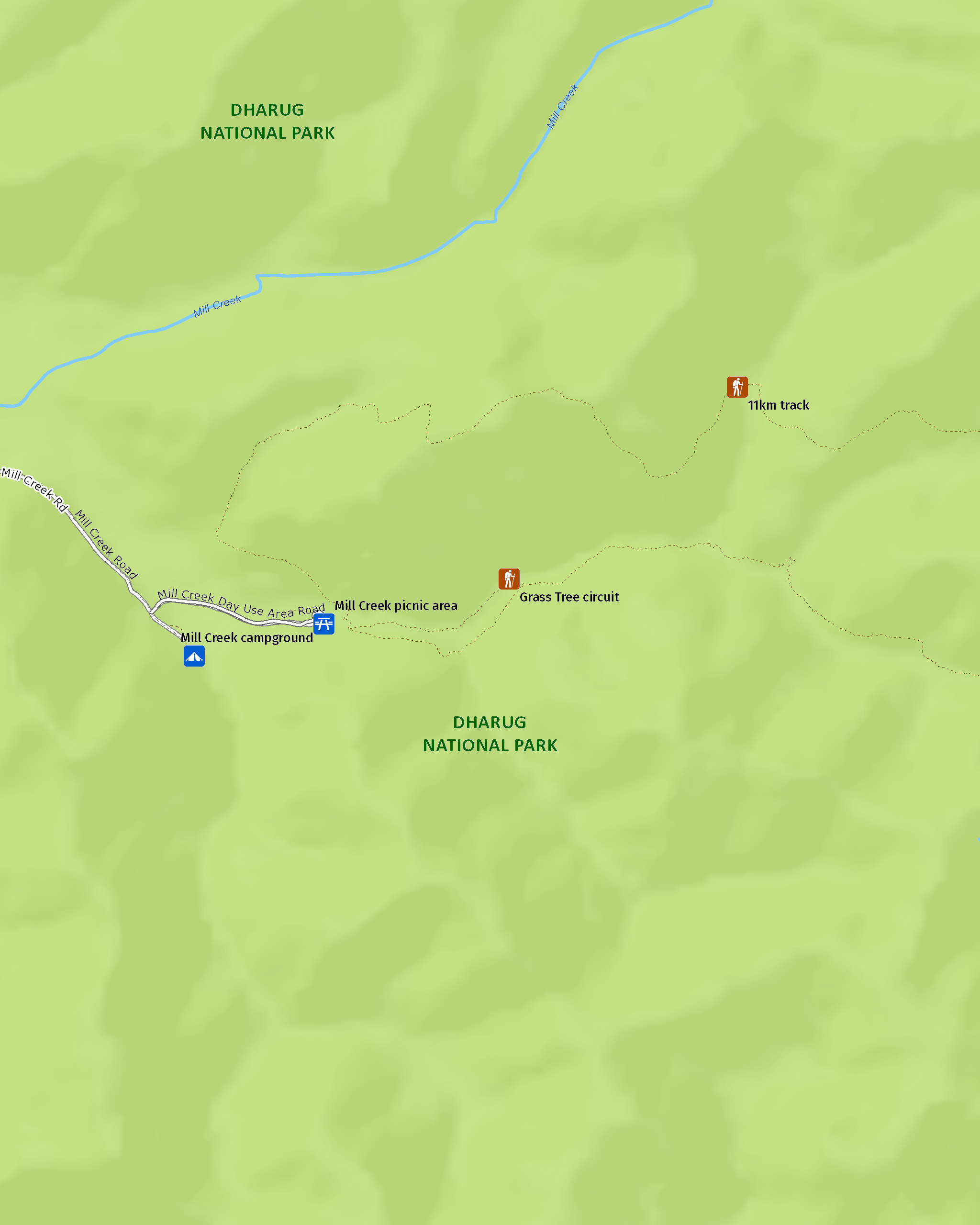
Map legend

Local alerts
For the latest updates on fires, closures and other alerts in this area, see https://www.nationalparks.nsw.gov.au/camping-and-accommodation/campgrounds/mill-creek-campground/local-alerts
Bookings
- National Parks Contact Centre
- 7am to 7pm daily
- 1300 072 757 (13000 PARKS) for the cost of a local call within Australia excluding mobiles
- parks.info@environment.nsw.gov.au
Operated by
- Bulga office
- Monday to Friday, 9.30am to 4pm.
- 02 6574 5555
- npws.wollemiyengo@environment.nsw.gov.au
- 2156 Putty Road, Bulga NSW 2330
Park info
- in Dharug National Park in the Sydney and surrounds region
Dharug National Park is always open but may have to close at times due to poor weather or fire danger.
Visitor info
All the practical information you need to know about Mill Creek campground.
Getting there and parking
Mill Creek campground is located 6.6km east of the Wisemans Ferry crossing, on the north side of the Hawkesbury River in Dharug National Park.
To get there, turn right from the ferry and follow signs for Dharug National Park – Mill Creek campground. Turn left and follow the road for 1.7km to the end, where you’ll find the campground. You can also reach the campground by taking Wisemans Ferry Road from the F3 exits at Calga, Gosford and Peats Ridge.
Road quality
- Sealed roads
Vehicle access
- 2WD vehicles
Weather restrictions
- All weather
Parking
Parking is available at Mill Creek campground in bitumen carparks, including 1 accessible parking space.
- For sites 1 to 8 you can park onsite with your campervan, camper trailer or small caravan (4m/13ft).
- For other sites, there are parking spaces along the road through the campground, with camping a short distance from your vehicle (20m to 100m).
Best times to visit
There are lots of great things waiting for you in Dharug National Park. Here are some of the highlights.
Autumn
The water has warmed up nicely by late summer so autumn is great for kayaking and canoeing along the Hawkesbury river.
Spring
The spring months are perfect for enjoying more strenuous activities in the park, like the longer walks and mountain bike riding. It's also the perfect time to see wildflowers.
Winter
The park is still stunning in winter and walking on sunny days is very pleasant. It can be cold at night so bring warm gear if you're camping.
Weather, temperature and rainfall
Summer temperature
Average
13°C and 27°C
Highest recorded
42.9°C
Winter temperature
Average
8°C and 18°C
Lowest recorded
-0.1°C
Rainfall
Wettest month
February and March
Driest month
September
The area’s highest recorded rainfall in one day
230.2mm
Facilities
- Tank water is available, however it’s not recommended for drinking.
- The exclusive group camp area has non-flush toilets and wood barbecues. It is suitable for tents only.
- There are no bins, so please take your rubbish with you when you leave.
Toilets
The toilets at this campground are accessible composting micro-flush toilets.
Barbecue facilities
There's a wood fire pit at each campsite. Firewood is not supplied.
- Wood barbecues
Carpark
Step-free access
The campground is mostly flat and step-free, with concrete and fibreglass pathways that lead from the carpark to the toilets.
Aside from the amenities footpath, there no other paths at the campground. You'll need to cross over flat grass to reach the rest of the facilities.
- Step-free outdoor pathways
Seats and resting points
There are sandstone logs that mark the edge of the campground, where you can rest.
There's also a fireplace near near sites 23 to 28 in the main campground that has 4 timber bench seats.
Maps and downloads
Accessibility
Disability access level - easy
Mill Creek campground is mostly flat and step-free, with the following accessible facilities:
- Concrete and fibreglass pathways that lead to the amenities
- 1 accessible parking spot in a bitumen carpark. You can also park directly at your campsite If you book sites 1-8.
- Accessible composting toilets
- Bench seats at one of the fireplaces, and sandstone logs around the edge of the campground where you can rest.
You'll need to cross over flat grass to reach the facilities that are not set along the pathways.
Prohibited
Amplified music is not permitted.
Floodlights are not permitted.
Drones
Flying a drone for recreational purposes is prohibited in this area. Drones may affect public enjoyment, safety and privacy, interfere with park operations, or pose a threat to wildlife. See the Drones in Parks policy.
This area may be a declared Drone Exclusion Zone, or may be subject to Civil Aviation Safety Authority (CASA) rules for flying near airports, aerodromes and helicopter landing sites. See CASA's Drone Flyer Rules.
Commercial filming and photography
Commercial filming or photography is prohibited without prior consent. You must apply for permission and contact the local office.
Gathering firewood
Generators
Pets
Pets and domestic animals (other than certified assistance animals) are not permitted. Find out which regional parks allow dog walking and see the pets in parks policy for more information.
Smoking
NSW national parks are no smoking areas.
Learn more
Mill Creek campground is in Dharug National Park. Here are just some of the reasons why this park is special:
Aboriginal heritage
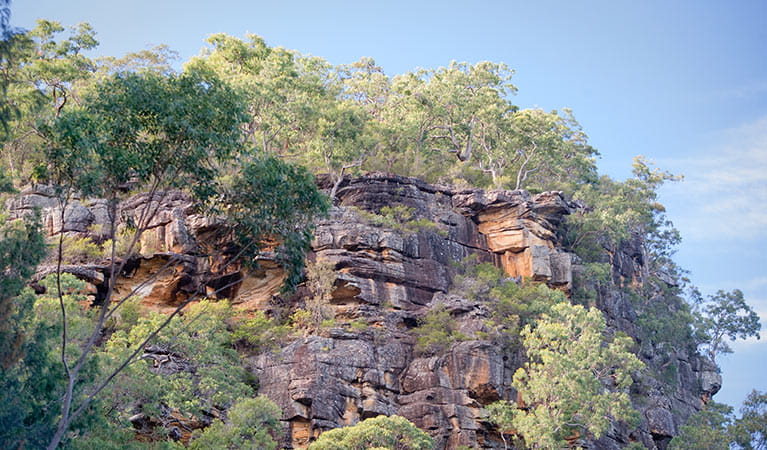
Dharug National Park is the traditional Country of the Dharug Aboriginal people. Abundant in animal, plant and bird life, the area was a rich source of food, medicines and shelter. The park's diverse landscapes and all they contain feature in all aspects of Aboriginal culture and are associated with Dreaming stories and cultural learning that is still passed on today.
Rugged beauty
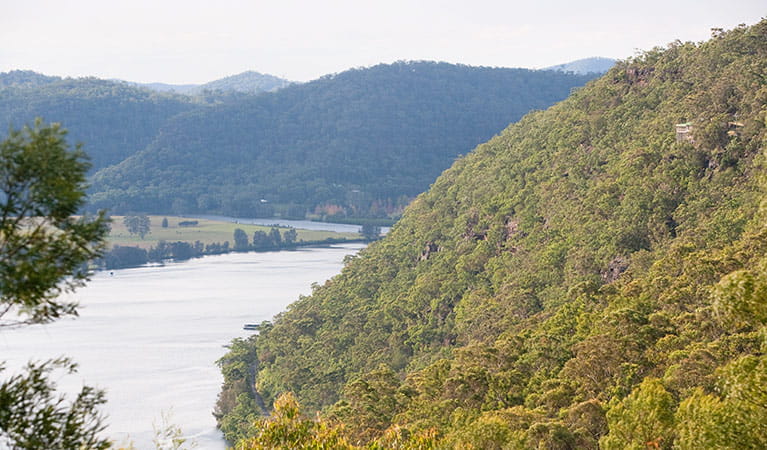
From the rugged bushland containing gang-gang cockatoos, satin bowerbirds and Lewin's honeyeaters to the sparkling waters of the creeks and the rich colours of the sandstone cliffs and formations, Dharug National Park offers a diverse range of landscapes. Bring your bike, bushwalk, camp by the creek, canoe on the Hawkesbury or make the most of the backdrop with your camera, there is so much to explore.
Step into Australia’s past
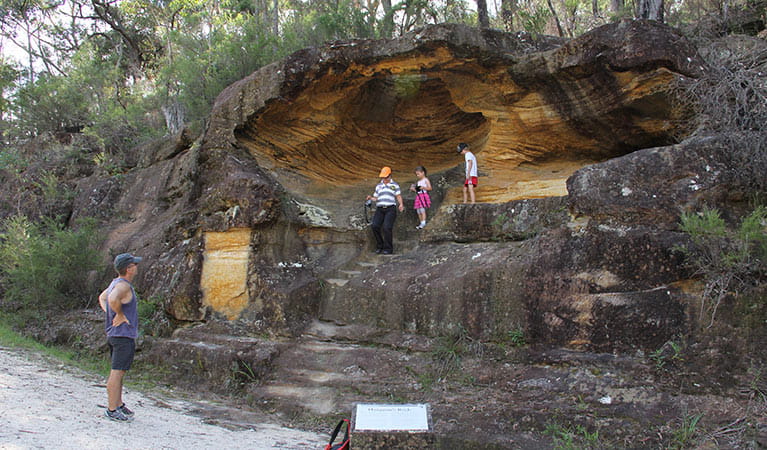
Dharug National Park contains the Old Great North Road, one of 11 historic sites which form the Australian Convict Sites World Heritage property. It's a spectacular example of early colonial engineering and demonstrates the use of convict labour; up to 720 convicts - some in chains - worked on the road, which spanned 264km, connecting Sydney to the settlements of the Hunter Valley. Only 43km of the road remains relatively intact, running from Wisemans Ferry in the south to Mount Manning in the north and includes the oldest surviving stone bridges in mainland Australia. It makes a great walk to explore over two or three days or an exhilarating day's cycle.
- Devines Hill loop Head to Devines Hill loop in Dharug National Park, near Wisemans Ferry this weekend for a bike ride or walk along the historic World Heritage-listed Devines Hill loop.
- Old Great North Road - World Heritage walk Old Great North Road – World Heritage walk highlights a historic convict-built road with scenic river views, via Finchs Line, in Dharug National Park.
Plants and animals protected in this park
Animals
-

Superb lyrebird (Menura novaehollandiae)
With a complex mimicking call and an elaborate courtship dance to match, the superb lyrebird is one of the most spectacular Australian animals. A bird watching must-see, the superb lyrebird can be found in rainforests and wet woodlands across eastern NSW and Victoria.
-
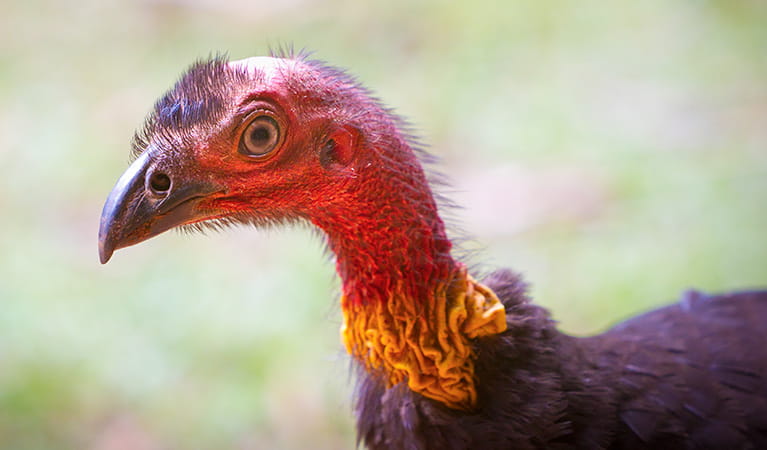
Australian brush turkey (Alectura lathami)
The Australian brush turkey, also known as bush or scrub turkey, can be found in rainforests along eastern NSW. With a striking red head, blue-black plumage and booming call, these distinctive Australian birds are easy to spot while bird watching in several NSW national parks.
-

Bare-nosed wombat (Vombatus ursinus)
A large, squat marsupial, the Australian bare-nosed wombat is a burrowing mammal found in coastal forests and mountain ranges across NSW and Victoria. The only other remaining species of wombat in NSW, the endangered southern hairy-nosed wombat, was considered extinct until relatively recently.
-
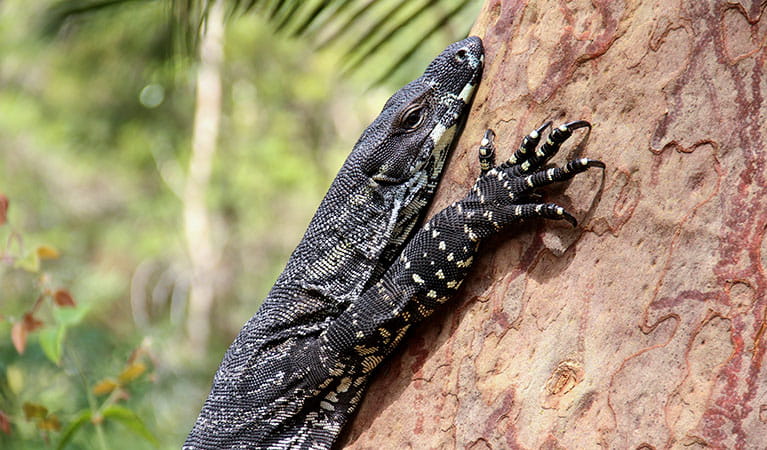
Lace monitor (Varanus varius)
One of Australia’s largest lizards, the carnivorous tree-dwelling lace monitor, or tree goanna, can grow to 2m in length and is found in forests and coastal tablelands across eastern Australia. These Australian animals are typically dark blue in colour with whitish spots or blotches.
Plants
-
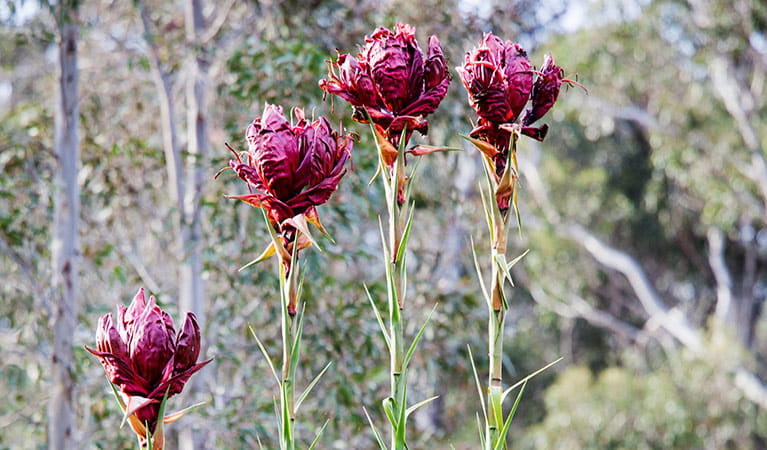
Gymea lily (Doryanthes excelsa)
The magnificent Gymea lily is one of the most unusual Australian native plants, found only along the coast and surrounding bushland of the Sydney Basin, from Newcastle to Wollongong. In spring this giant lily shoots out spectacular red flowers that can reach heights of 2-4m.

